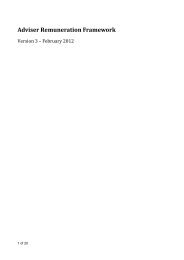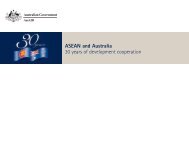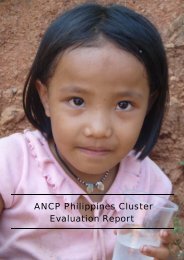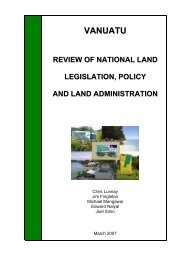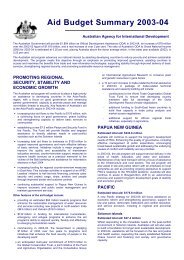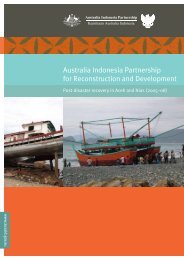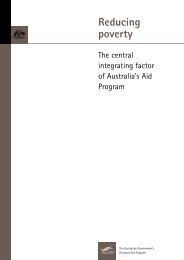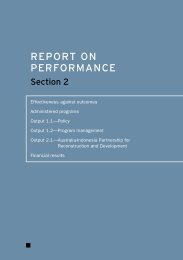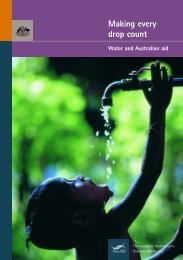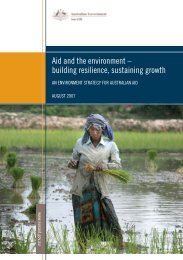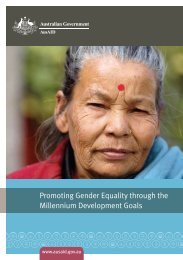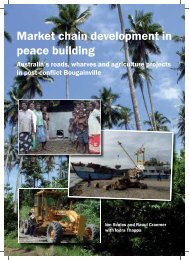Australian Aid to PNG - AusAID
Australian Aid to PNG - AusAID
Australian Aid to PNG - AusAID
Create successful ePaper yourself
Turn your PDF publications into a flip-book with our unique Google optimized e-Paper software.
The second and current Treaty came in<strong>to</strong> effect in July 2000, following thecessation of budget support in June 2000. It provides the framework for currentand future <strong>Australian</strong> aid <strong>to</strong> Papua New Guinea. It establishes ceilings on thelevel of <strong>Australian</strong> aid funding and ensures the aid program will continue <strong>to</strong>focus on helping <strong>to</strong> reduce poverty and promote sustainable growth. The newTreaty also specifies generic and sec<strong>to</strong>r-specific performance targets andbenchmarks. Performance against these benchmarks is reviewed and assessedannually, and will be used <strong>to</strong> determine the type and volume of future<strong>Australian</strong> assistance. This is the first time such an approach has been taken inthe <strong>Australian</strong> aid program.4.2 Budget SupportMore than two-thirds (A$9.3 billion) of <strong>Australian</strong> aid <strong>to</strong> Papua New Guineasince independence has been provided in the form of untied budget supportgrants. Although budget support was seen in the early years as providingnecessary aid assistance, while giving Papua New Guinea management controlover decision-making, by 1980 there were emerging concerns in bothgovernments. The availability of budget support acted as a disincentive for PapuaNew Guinea <strong>to</strong> take difficult economic decisions in the interests of equitablegrowth, and little effort was made <strong>to</strong> diversify the Papua New Guinea economy.There were various ‘false starts’ in the combined effort <strong>to</strong> reduce Papua NewGuinea’s reliance on budget support grants. Until the late 1980s, each attempt<strong>to</strong> reduce budget support was softened in response <strong>to</strong> different external shocksand internal difficulties facing Papua New Guinea. These decisions were basedvery much on the special relationship between Australia and Papua NewGuinea, rather than real need. Whilst the economic problems confronting PapuaNew Guinea were certainly real, the situation was not desperate, and it wasrecognised at the time that there was much Papua New Guinea itself could havedone <strong>to</strong> manage its economic problems (eg, reducing new expenditure; usingtied, concessional assistance from other sources; and relaxing the “hard kina"policy). Not surprisingly, the Papua New Guinea government had never beenkeen <strong>to</strong> bring these options in<strong>to</strong> play (or <strong>to</strong> accept programmed assistance) forfear of jeopardising Australia’s <strong>to</strong>tally unconditional budget support grants.The final decision <strong>to</strong> phase out budget support 9 was not taken lightly, and wasthe subject of significant debate in both countries. In Papua New Guinea, thedesire for genuine self-reliance competed with the attraction of assured,unconditional funding. In Australia, some questioned Papua New Guinea’sability <strong>to</strong> adjust <strong>to</strong> programmed assistance, and there was reluctance <strong>to</strong> risk9 Encapsulated in the first Treaty on Development Cooperation, 1989.26 The Contribution of <strong>Australian</strong> <strong>Aid</strong> <strong>to</strong> Papua New Guinea’s Development 1975–2000



